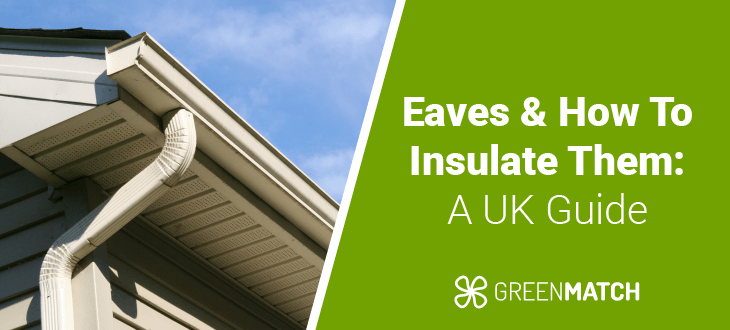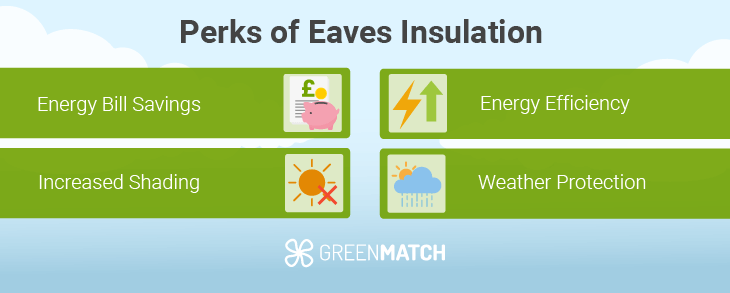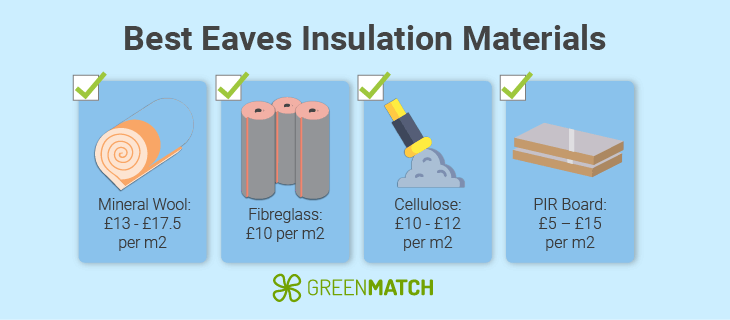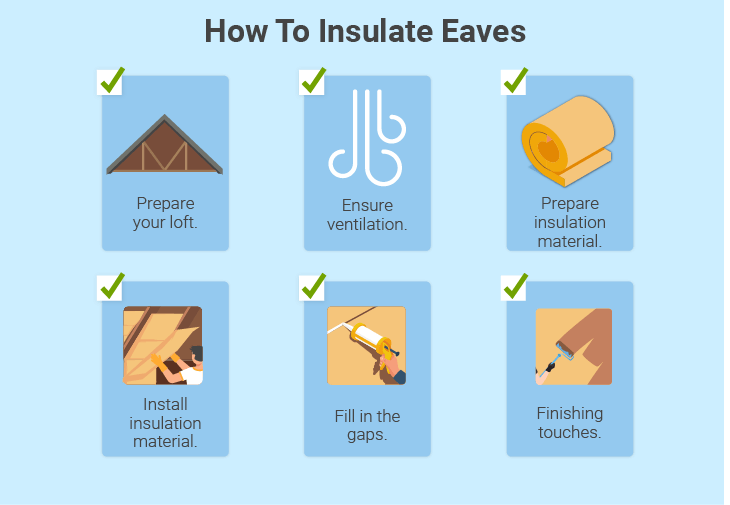Answer these simple questions and we will find you the BEST prices
Which type of solar quotes do you need?
It only takes 30 seconds
100% free with no obligation

Get Free quotes from insulation specialists near you

Save money by comparing quotes and choosing the most competitive offer

The service is 100% free and with no obligation
- GreenMatch
- Insulation
- Roof Insulation
- Eaves Insulation
Everything You Need to Know About Eaves Insulation


- Eaves are the protruding part of a home's roof structure. Not only do they provide aesthetic value, but they are also key in reflecting away heavy rainfall and snow from your immediate home perimeter.
- Eaves can normally be insulated from within the loft itself. In some exceptional cases, eaves may need to be insulated externally.
- Mineral wool, fibreglass, and cellulose are some of the most popular insulation materials for roof eaves.
Eaves are a structurally important and asethetically pleasing element of pitched roof homes. The eaves are the portion of your roof structure that overhangs the exterior of your home, offering protection from heavy rain and snow, preventing water retention on your roof structure, and also adding a decorative spark to your home's facade.
But do eaves need insulating? How is this done? You've come to the right place if you’ve asked these questions and more. This ultimate guide by GreenMatch UK will walk you through all you need to know about eave insulation, including benefits, best materials, and a step-by-step guide to the insulation process.
Ready to enjoy the benefits of home insulation? Let GreenMatch UK free you from the endless burden of researching and vetting installers. Spend just 30 seconds filling out our online form and receive 3 free home-tailored quotes from our nationwide network of trusted experts. Click below to begin!
- Describe your needs
- Get free quotes
- Choose the best offer
It only takes 30 seconds



Is insulating eaves necessary?
Eaves insulation is a great follow-up when you insulate your loft. Provided that sufficient room is left for ventilation and airflow, insulating the eaves of your roof can enhance the thermal envelope of your house. This allows it to better retain heat in the winter, and cool in the summer.
However, the absence of healthy ventilation can lead to condensation buildup within your loft, creating the risk of mould and rot not just for your loft eaves insulation, but the insulation and structural integrity of your entire loft space.
All in all, insulating your eaves is a necessary step if you want to achieve full thermal efficiency in your home, but it's highly recommended to work with a professional installer who can ensure sufficient space is created for ventilation.
Benefits of eaves insulation

Aside from providing a better thermal envelope for your home, insulating your eaves comes with a series of other benefits worth considering. Here’s a breakdown of what you could expect:
- Energy bill savings: Insulating your eaves alongside loft or roof insulation will further enhance your home's ability to retain heat. This will be reflected in annual energy bill reductions as your energy system needs less work to maintain an internal temperature.
- Increased shade: The wider the eaves, the more shade is provided to your surrounding house perimeter. This shade from the overhanging roof helps keep your house cooler in hotter climates by reducing direct sun exposure.
- Energy efficiency: The extra shading provided by eaves will make it easier to cool your home, leading to less use of your energy system in the summer months. This will reduce your carbon footprint, but also your monthly cooling costs.
- Weather protection: Much like an umbrella, eaves ensure that rainfall and snow are diverted away from the immediate home perimeter. This helps keep walls and foundations dry, reducing the risk of moisture ingress, erosion, mould, and rot.
All in all, eaves without insulation are already a great addition to a pitched roof house, however adding insulation material will help you enjoy the full spectrum of benefits these house features have to offer.
What are the best eaves insulation materials?

Eaves are usually insulated using the same materials used to insulate your roof or loft. While there is no best insulation for loft and eaves, some popular materials on the market are great choices to consider. Here’s some to look into:
- Mineral wool: Made from rock or glass, mineral wool is a blanket-style insulation material that is popular for insulation jobs due to its cost-effectiveness. Priced at around £13 - £17.5 per m2, mineral wool is also relatively sustainable and easy to recycle.
- Fibreglass: Similar to mineral wool but much more affordable, fibreglass is made from recycled glass products and costs around £10 per m2. While providing a lesser thermal efficiency, fibreglass is corrosion-resistant, electrically non-conductive, and flame-resistant, making it a safe long-term material to install as insulation.
- Cellulose: Possibly one of the most sustainable materials on the market, cellulose is made entirely from recycled paper and wood materials. Costing around £10 - £12 per m2, it’s most convenient for hard-to-access eave spaces as it can be added as loose fill.
- PIR boards: These rigid insulation boards cost £5 – £15 per m2, and are made from a polymer called polyisocyanurate. PIR has some of the highest heat retention properties of all materials, is very durable, and its rigidness improves the structural integrity of your eaves. However, polyisocyanurate is a polymer that is unsustainable to produce and difficult to recycle.
Ultimately, the best insulation material for your eaves will hinge on several key factors, such as existing loft insulation, your budget range, and other preferences. Working with professional loft insulation companies can help make sure you follow the best course of action.
By spending just 30 seconds filling out our online form, you can receive up to 3 free home-tailored quotes from our network of trusted professionals. No charges, no obligations. Click below to begin!
- Describe your needs
- Get free quotes
- Choose the best offer
It only takes 30 seconds



How to insulate eaves

While it’s best to leave insulation jobs to the experts, it’s possible to insulate your eaves as a DIY project, provided that you are handy with crafts.
Here’s a breakdown of how that process works:
- Prepare your loft: Before any work can begin, the loft area must be cleaned of obstructions and debris. This includes relocating wires and addressing outstanding repairs such as cracks, gaps and openings that can compromise the thermal envelope of your loft. The effectiveness and longevity of your eaves insulation rely on your loft being in good condition.
- Ensure ventilation: Without a loft insulation eaves gap for ventilation, warm air in your house will rise and condense indoors, leading to mould and rot. Installing attic fans, or vents can help drain hot moist air out of your home. Leaving a 50mm air gap between your insulation material and the eaves covering can also help prevent moisture ingress.
- Prepare insulation material: Use a tape measure to find out the length and width of insulation material you need. Measure the total area of the eaves space by multiplying the length and width. Then measure the space and depths between each eaves rafter to know how much insulation it can contain. Once you have these measurements, you can go ahead and cut the corresponding amount of insulation. Keep it snug!
- Install insulation material: Start by snugly fitting the sheets of insulation in between the rafter shafts. If you make sure to cut the insulation as snug as you can get it, you won’t need an adhesive or cover to keep the insulation in place. If needed, you can use a staple gun or a similar non-adhesive method.
- Finishing touches: You may find some gaps that weren’t accounted for. You can cut some smaller portions of insulation from your remaining material to fill in these gaps and crevices. Try to cut the required shapes to fill the gaps, and don't overdo the amount of material.
- Cover it up: Once everything is in place, you may use plasterboard to cover up the insulation material, keeping it safe and creating a more seamless finish. For aesthetic details, the plasterboard can be painted, or secured with wallpaper or other finishes.
By following these steps, insulating eaves as a DIY project is more than possible. Regardless, it’s best recommended to work with a professional installer who can expertly guide the process and make sure everything is done to the highest of standards. Experts are also well versed in insulation building regulations and can ensure everything happens up to code.
Is insulating eaves a good option for your loft?
All things considered, insulating eaves is a great option for your loft. It enhances the effectiveness of your loft insulation and creates a full thermal envelope, which will be reflected in bigger energy bill savings, a smaller carbon footprint, and a much more comfortable home.
However, the hard part starts with trying to find the perfect roof insulation installer at the right price. Most prospective customers find themselves stuck in an endless loop of websites and phone calls, with no steps closer to a deal-breaking bargain. Luckily, GreenMatch UK can help.
With just 30 seconds of your time to fill out our intake form, we can send you up to 3 free home-tailored quotes from our nationwide network of pre-vetted experts. The best part? Our services are completely free of charges and obligations. Click below to get started!
- Describe your needs
- Get free quotes
- Choose the best offer
It only takes 30 seconds



FAQ
You should insulate the eaves of your roof to achieve a full thermal envelope for your loft insulation. In doing so, it’s important to account for ventilation and air gaps to make sure the insulation material stays in good condition for years to come.
There is no single best insulation for roof eaves, but mineral wool, fibreglass, and cellulose tend to be popular options due to their budget-friendliness and relative sustainability. There are also rigid insulation boards – like PIR – that provide superior thermal efficiency but aren’t sustainable.
Sloping eaves can be insulated from within the loft by fitting insulation material into the rafters of the eaves, and then covering it up with plasterboard for a seamless finish. Working with a professional installer can ensure this job is done to the highest standard.

Akif is a copywriter at GreenMatch since 2023. With a keen interest in community sustainability, green solutions and the role of digital media in identifying climate trends, he aims to hone in on his background in International Studies and Digital Media to provide a multidisciplinary approach to written content rooted in credible research and accuracy.
We strive to connect our customers with the right product and supplier. Would you like to be part of GreenMatch?

